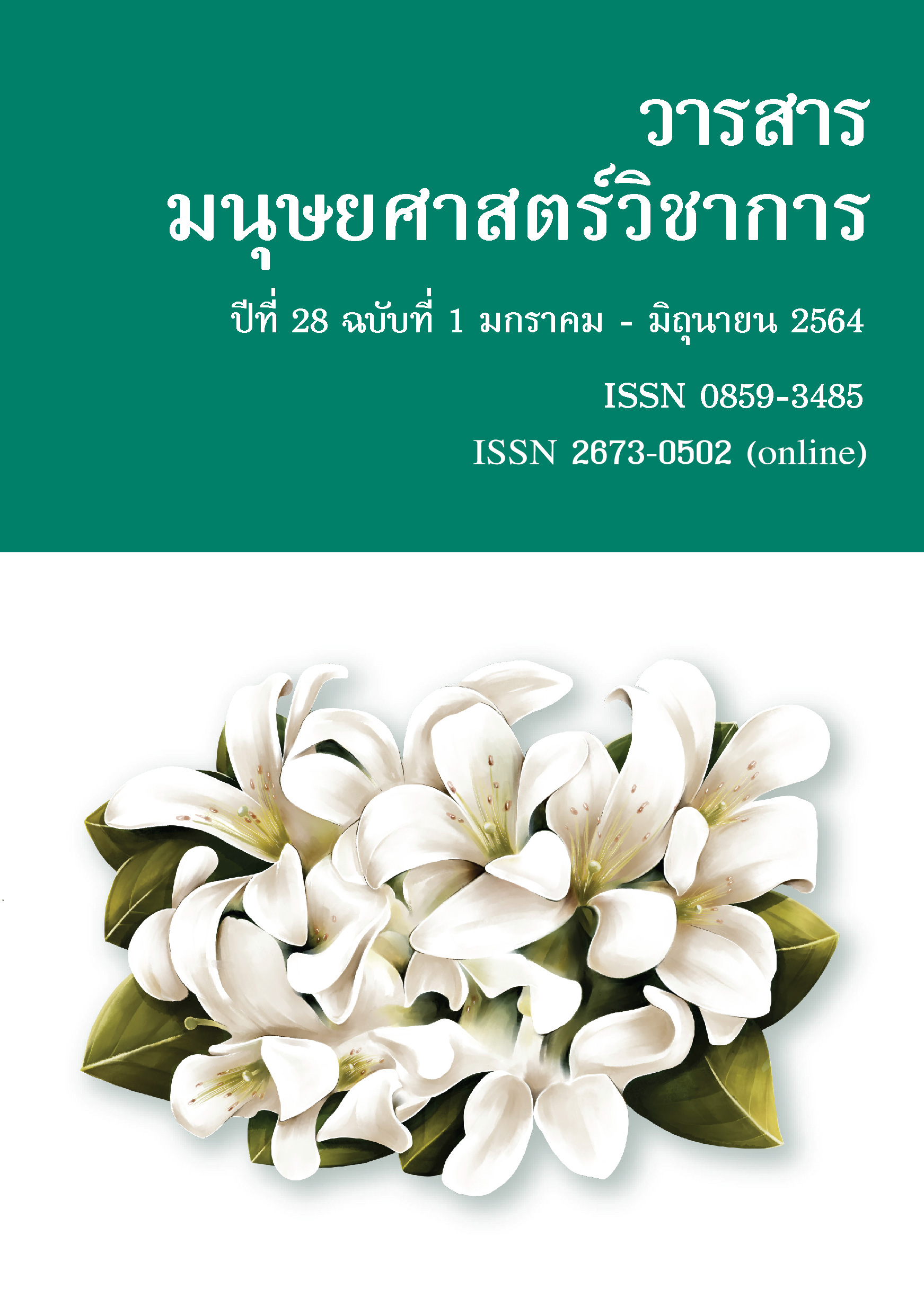เสียงของผู้หญิงข้ามเพศ การศึกษาความสัมพันธ์ของช่วงเวลาเริ่มเสียงก้องของพยัญชนะกักในภาษาไทยกับองค์ประกอบสร้างของตัวตนทางเพศ
Main Article Content
บทคัดย่อ
การศึกษานี้มีวัตถุประสงค์เพื่อ 1) วิเคราะห์ค่าช่วงเวลาเริ่มเสียงก้องของพยัญชนะกักในภาษาไทยทั้ง 3 ประเภทคือ พยัญชนะกักก้อง กักไม่ก้องไม่พ่นลมและกักไม่ก้องพ่นลมของผู้หญิงข้ามเพศและเปรียบเทียบกับผู้ชายและผู้หญิง 2) ศึกษาองค์ประกอบสร้างของตัวตนทางเพศของผู้หญิงข้ามเพศด้วยค่าดัชนีความเป็นหญิงและความสัมพันธ์ระหว่างค่าช่วงเวลาเริ่มเสียงก้องกับดัชนีความเป็นหญิง ผู้วิจัยทดสอบความแตกต่างของค่าช่วงเวลาเริ่มเสียงก้องระหว่างผู้พูด 3 กลุ่มด้วยสถิติ One-way Anova เก็บข้อมูลด้วยแบบสอบถามมาตรวัดลิเคิร์ทสเกล 5 ระดับซึ่งประกอบด้วยคำถามที่สะท้อนอัตลักษณ์ทางเพศ และเพศวิถี เพื่อเก็บข้อมูลสำหรับคำนวณเป็นค่าดัชนีความเป็นหญิง และวิเคราะห์ความสัมพันธ์ระหว่างค่าช่วงเวลาเริ่มเสียงก้องกับองค์ประกอบสร้างตัวตนทางเพศด้วยการวิเคราะห์สหสัมพันธ์เพียร์สัน
ผลการศึกษาพบว่า ค่าช่วงเวลาเริ่มเสียงก้องของผู้หญิงข้ามเพศมีค่าระยะเวลายาวกว่าผู้ชายและผู้หญิงอย่างมีนัยสำคัญทางสถิติที่ระดับ p < 0.01 และพบว่าพยัญชนะกักก้องและกักไม่ก้องไม่พ่นลมมีความสัมพันธ์เชิงบวกกับค่าดัชนีความเป็นหญิงของผู้หญิงข้ามเพศแต่ละคน โดยมีนัยสำคัญทางสถิติอยู่ที่ p < 0.01 ในขณะที่ค่าช่วงเวลาเริ่มเสียงก้องของพยัญชนะกักก้องไม่พบความสัมพันธ์กับค่าดัชนีความเป็นหญิง ข้อค้นพบนี้แสดงให้เห็นเอกลักษณ์ทางเสียงของผู้หญิงข้ามเพศที่แตกต่างจากผู้ชายและผู้หญิง และการแปรภายในกลุ่มของเสียงผู้หญิงข้ามเพศซึ่งสัมพันธ์กับองค์ประกอบสร้างตัวตนทางเพศ
Article Details
เอกสารอ้างอิง
ชัชวาล เรืองประพันธ์. (2543). สถิติพื้นฐานพร้อมตัวอย่างการวิเคราะห์ด้วยโปรแกรม MINITAB SPSS และ SAS. ขอนแก่น: มหาวิทยาลัยขอนแก่น.
ตามใจ อวิรุทธิโยธิน. (2553). ช่วงเวลาเริ่มเสียงก้องของพยัญชนะกักในภาษาไทยมาตรฐานสำเนียงใต้และภาษาไทยมาตรฐานสำเนียงใต้และภาษาไทยมาตรฐาน (วิทยานิพนธ์ปริญญาดุษฎีบัณฑิต). จุฬาลงมหากรณ์มหาวิทยาลัย, กรุงเทพฯ.
นฤพนธ์ ด้วงวิเศษ. (2558). วิพากษ์ “ความเป็นหญิง” ของหญิงในร่างชาย. สืบค้นจาก http://www.sac.or.th/databases/anthropology-concepts/articles/9
Abramson, A., & Lisker, L. (1964). A Cross-Language Study of Voicing in Initial Stops: Acoustical Measurements (Vol. 20).
Bralley, R. C., Bull, G. L., Gore, C. H., & Edgerton, M. T. (1978). Evaluation of vocal pitch in male transsexuals. Journal of Communication Disorders, 11(5), 443-449.
Cho, T., & Ladefoged, P. (1999). Variation and universals in VOT: Evidence from 18 languages (Vol. 27).
Günzburger Ph.D, D. (1995). Acoustic and perceptual implications of the transsexual voice (Vol. 24).
Kessinger, R. H., & Blumstein, S. E. (1997). Effects of speaking rate on voice-onset time in Thai, French, and English. Journal of Phonetics, 25(2), 143-168.
King, R. S., Brown, G. R., & McCrea, C. R. (2012). Voice Parameters That Result in Identification or Misidentification of B iological Gender in Male-to-Female Transgender Veterans. International Journal of Transgenderism, 13(3), 117-130.
Lerman, J. W., & Damsté, P. H. (1969). Voice Pitch of Homosexua ls. Folia Phoniatrica et Logopaedica, 21(5), 340-346.
Li, F. (2013). The effect of speakers’ sex on voice onset time in Mandarin stops. The Journal of the Acoustical Society of America, 133 (2), EL142-EL147.
Likert, R. (1961). New patterns of management. New York: McGraw-Hill.
Morris, R. J., McCrea, C. R., & Herring, K. D. (2008). Voice onset time differences between adult males and females: Isolated syllables. Journal of Phonetics, 36(2), 308-317.
Mount, K. H., & Salmon, S. J. (1988). Changing the vocal characteristics of a postoperative transsexual patient: A longitudinal study. Journal of Communication Disorders, 21(3), 229-238.
Netsell, R., Lotz, W. K., DuChane, A. S., & Barlow, S. M. (1991). Vocal tract aerodynamics during syllable productions: Normative data and theoretical implications. Journal of Voice, 5(1), 1-9.
Oh, E. (2011). Effects of speaker gender on voice onset time in Korean stops. Journal of Phonetics, 39(1), 59-67.
Peng, J.-F., Chen, L.-M., & Lee, C.-C. (2018). Tonal Effects on Voice Onset Time.
Rogers, H., & Smyth, R. (2003). Phonetic Differences between Gay-and Straight-Sounding Male Speakers of North American English. Paper presented at the 15th International Congress of Phonetics Sciences, Barcelona, Spain.
Rovinelli, R., & Hambleton, R. (1977). On the use of content specialists in the assessment of criterion-referenced test item validity (Vol. 2).
Swartz, B. L. (1992). Gender Difference in Voice Onset Time. Perceptual and Motor Skills, 75(3), 983-992.
Whiteside, S. P., Henry, L., & Dobbin, R. (2004). Sex differences in voice onset time: A developmental study of phonetic context effects in British English. The Journal of the Acoustical Society of America, 116(2), 1179-1183.
Zimman, L. (2017). Variability in /s/ among transgender speakers: Evidence for a socially grounded account of gender and sibilants. In Linguistics (Vol. 55, pp. 993).


